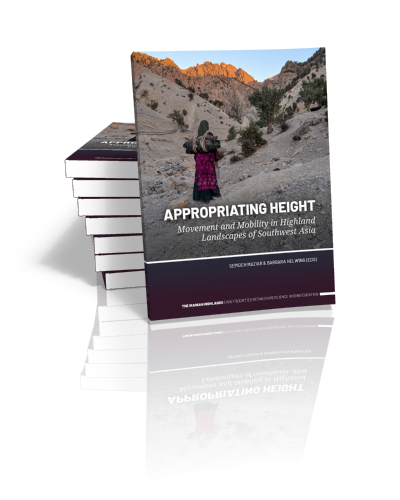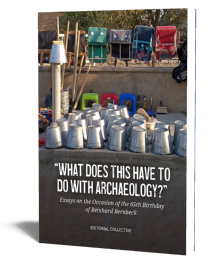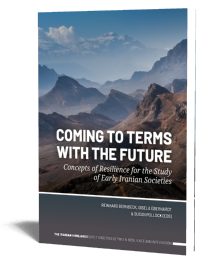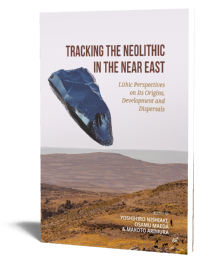Appropriating Height
Movement and Mobility in Highland Landscapes of Southwest Asia
Edited by Sepideh Maziar & Barbara Helwing | 2024

Appropriating Height
Movement and Mobility in Highland Landscapes of Southwest Asia
Edited by Sepideh Maziar & Barbara Helwing | 2024
Paperback ISBN: 9789464271089 | Hardback ISBN: 9789464271096 | Imprint: Sidestone Press Academics | Format: 210x280mm | 198 pp. | series: The Iranian Highlands. Early Societies between Resilience and Integration 2 | Language: English | 24 illus. (bw) | 64 illus. (fc) | Keywords: archaeology; highland regions; human mobility; anthropological discourse; spatial behavior; adaptive strategies; resilience; resources; vulnerability | download cover | DOI: 10.59641/pp456sb | CC-license: CC BY 4.0
Read online 221 times
- Digital & Online access
-
Buy via Sidestone (EU & UK)
-
Buy via our Distributors (WORLD)
For non-EU or UK destinations you can buy our books via our international distributors. Although prices may vary this will ensure speedy delivery and reduction in shipping costs or import tax. But you can also order with us directly via the module above.
UK international distributor
USA international distributor
-
Bookinfo
Paperback ISBN: 9789464271089 | Hardback ISBN: 9789464271096 | Imprint: Sidestone Press Academics | Format: 210x280mm | 198 pp. | series: The Iranian Highlands. Early Societies between Resilience and Integration 2 | Language: English | 24 illus. (bw) | 64 illus. (fc) | Keywords: archaeology; highland regions; human mobility; anthropological discourse; spatial behavior; adaptive strategies; resilience; resources; vulnerability | download cover | DOI: 10.59641/pp456sb | CC-license: CC BY 4.0
Read online 221 times

We will plant a tree for each order containing a paperback or hardback book via OneTreePlanted.org.
The essays in this book focus on archaeological approaches to the utilization of highland regions in southwestern and central Asia, examining the interplay between human communities and highland landscapes from the Paleolithic era to the present.
Contributions combine case studies with theoretical considerations to explore adaptive strategies of movement. They discuss the significance of mobility within archaeological and anthropological discourse. Contributors engage with critical questions: How can archaeologists discern traces of movement and unravel material footprints of diverse mobility? How can they track shifts in mobility through time or regions? By systematizing observations on human spatial behavior across epochs and settings, these essays seek to test and refine traditional archaeological methodologies. They present nuanced frameworks and shed light on the adaptability and resilience of these communities.
“Appropriating Height” aims to understand the human experience in highland environments. It is essential for those fascinated by the entanglement between people, place, and time, providing a comprehensive perspective on the legacy of human movement.
This book is the second volume of a series published by the German-Iranian research cooperation “The Iranian Highlands: Resiliences and Integration in Premodern Societies”. The goal of the research project is to shine a new light on communities and societies that populated the Iranian highlands and their more or less successful strategies to cope with the many vagaries, the constant changes and risks of their natural and humanly shaped environments.
Tracing footprints: a prelude to highland mobility
Barbara Helwing and Sepideh Maziar
Living with the vertical – models for mountain archaeology in southwest Asian highlands
Sabine Reinhold
Migration studies and highland mobility
Stephan Burmeister
Being entangled between adaptability and vulnerability: shall we define a new paradigm for migration studies in archaeology?
Sepideh Maziar
Mobility and practical choices in Eurasian prehistory
Michael D. Frachetti
Women, movement, and pottery making
Roghayeh Rahimi Sorkhani
Kura Araxes mobility: search for pastures and raw materials?
Thomas Stöllner, Irina Gambaschidze, Giorgi Gogochuri, Rémi Berthon, Andreas Hauptmann, Nikolas Heil, Gian Maria Di Nocera, Iman Mostafapour, Adeline Vautrin,
A multiproxy approach to identify occupation and mobility patterns of a pastoral community of the Late fourth millennium at Arslantepe (Period VI B1)
Giulio Palumbi, Marcella Frangipane, Francesca Balossi Restelli, Susanna Cereda, Paola Iacumin, Rana Özbal, Burhan Ulaş
Pastoralism as a spectrum: modeling variability in pastoral mobilities and economies in the Kura-Araxes cultural tradition
Siavash Samei
Reconstructing the Middle and Upper Palaeolithic hominin settlement pattern and movement corridors in the Kermanshah region
Masoud Yousefi, Anooshe Kafash, Elham Ghasidian, Saman Heydari‑Guran
Dr. Sepideh Maziar
Sepideh Maziar is an associate researcher at the Goethe University of Frankfurt. She got her undergraduate degree in archaeology from the University of Tehran in Iran and achieved her Ph.D. in southwest Asian archaeology from Goethe university of Frankfurt, Germany. She directed archaeological fieldwork in Iran and Azerbaijan and is currently engaged in excavation the Prehistory site of Tappeh Balu in Iran and Kültepe II in Naxçivan. Her research interests include migration, social identity, collective memory, social networks, and resilience strategies in diasporic contexts, with a focus on prehistoric communities of southwest Asia.
Dr. Barbara Helwing
Barbara Helwing is an archaeologist holding a PhD in Prehistoric and Near Eastern Archaeology from the University of Heidelberg. After stations in Ankara, Berlin, Lyon and Sydney, she is currently the director of the Museum of the Ancient Near East SMB PK in Berlin, Germany, and honorary professor at the Freie Universität Berlin and the University of Sydney, Australia. She has directed archaeological fieldwork in Iran, Turkey, Azerbaijan, and Sri Lanka, and is currently engaged in excavating the late PPNB site Gürcü Tepe in Turkey. Among her significant publications are the edited volumes “Early Mining and Metallurgy on the western Central Iranian Plateau (2011, with A. Vatandoust and H. Parzinger) and “The Kura Projects” (2017, with T. Aliyev, B. Lyonnet, F. Guliyev, S. Hansen, and G. Mirtskhulava). Her research interests focus on the emergence of social inequality, and on the history of technology and innovations and their cultural impact, with a special perspective on the role of metallurgy therein.
Abstract:
The essays in this book focus on archaeological approaches to the utilization of highland regions in southwestern and central Asia, examining the interplay between human communities and highland landscapes from the Paleolithic era to the present.
Contributions combine case studies with theoretical considerations to explore adaptive strategies of movement. They discuss the significance of mobility within archaeological and anthropological discourse. Contributors engage with critical questions: How can archaeologists discern traces of movement and unravel material footprints of diverse mobility? How can they track shifts in mobility through time or regions? By systematizing observations on human spatial behavior across epochs and settings, these essays seek to test and refine traditional archaeological methodologies. They present nuanced frameworks and shed light on the adaptability and resilience of these communities.
“Appropriating Height” aims to understand the human experience in highland environments. It is essential for those fascinated by the entanglement between people, place, and time, providing a comprehensive perspective on the legacy of human movement.
This book is the second volume of a series published by the German-Iranian research cooperation “The Iranian Highlands: Resiliences and Integration in Premodern Societies”. The goal of the research project is to shine a new light on communities and societies that populated the Iranian highlands and their more or less successful strategies to cope with the many vagaries, the constant changes and risks of their natural and humanly shaped environments.
Contents
Tracing footprints: a prelude to highland mobility
Barbara Helwing and Sepideh Maziar
Living with the vertical – models for mountain archaeology in southwest Asian highlands
Sabine Reinhold
Migration studies and highland mobility
Stephan Burmeister
Being entangled between adaptability and vulnerability: shall we define a new paradigm for migration studies in archaeology?
Sepideh Maziar
Mobility and practical choices in Eurasian prehistory
Michael D. Frachetti
Women, movement, and pottery making
Roghayeh Rahimi Sorkhani
Kura Araxes mobility: search for pastures and raw materials?
Thomas Stöllner, Irina Gambaschidze, Giorgi Gogochuri, Rémi Berthon, Andreas Hauptmann, Nikolas Heil, Gian Maria Di Nocera, Iman Mostafapour, Adeline Vautrin,
A multiproxy approach to identify occupation and mobility patterns of a pastoral community of the Late fourth millennium at Arslantepe (Period VI B1)
Giulio Palumbi, Marcella Frangipane, Francesca Balossi Restelli, Susanna Cereda, Paola Iacumin, Rana Özbal, Burhan Ulaş
Pastoralism as a spectrum: modeling variability in pastoral mobilities and economies in the Kura-Araxes cultural tradition
Siavash Samei
Reconstructing the Middle and Upper Palaeolithic hominin settlement pattern and movement corridors in the Kermanshah region
Masoud Yousefi, Anooshe Kafash, Elham Ghasidian, Saman Heydari‑Guran
Dr. Sepideh Maziar
Sepideh Maziar is an associate researcher at the Goethe University of Frankfurt. She got her undergraduate degree in archaeology from the University of Tehran in Iran and achieved her Ph.D. in southwest Asian archaeology from Goethe university of Frankfurt, Germany. She directed archaeological fieldwork in Iran and Azerbaijan and is currently engaged in excavation the Prehistory site of Tappeh Balu in Iran and Kültepe II in Naxçivan. Her research interests include migration, social identity, collective memory, social networks, and resilience strategies in diasporic contexts, with a focus on prehistoric communities of southwest Asia.
Dr. Barbara Helwing
Barbara Helwing is an archaeologist holding a PhD in Prehistoric and Near Eastern Archaeology from the University of Heidelberg. After stations in Ankara, Berlin, Lyon and Sydney, she is currently the director of the Museum of the Ancient Near East SMB PK in Berlin, Germany, and honorary professor at the Freie Universität Berlin and the University of Sydney, Australia. She has directed archaeological fieldwork in Iran, Turkey, Azerbaijan, and Sri Lanka, and is currently engaged in excavating the late PPNB site Gürcü Tepe in Turkey. Among her significant publications are the edited volumes “Early Mining and Metallurgy on the western Central Iranian Plateau (2011, with A. Vatandoust and H. Parzinger) and “The Kura Projects” (2017, with T. Aliyev, B. Lyonnet, F. Guliyev, S. Hansen, and G. Mirtskhulava). Her research interests focus on the emergence of social inequality, and on the history of technology and innovations and their cultural impact, with a special perspective on the role of metallurgy therein.
- Digital & Online access
-
Buy via Sidestone (EU & UK)
-
Buy via our Distributors (WORLD)
For non-EU or UK destinations you can buy our books via our international distributors. Although prices may vary this will ensure speedy delivery and reduction in shipping costs or import tax. But you can also order with us directly via the module above.
UK international distributor
USA international distributor
- Browse all books by subject
-
Search all books

We will plant a tree for each order containing a paperback or hardback book via OneTreePlanted.org.
You might also like:
© 2025 Sidestone Press KvK nr. 28114891 Privacy policy Sidestone Newsletter Terms and Conditions (Dutch)








